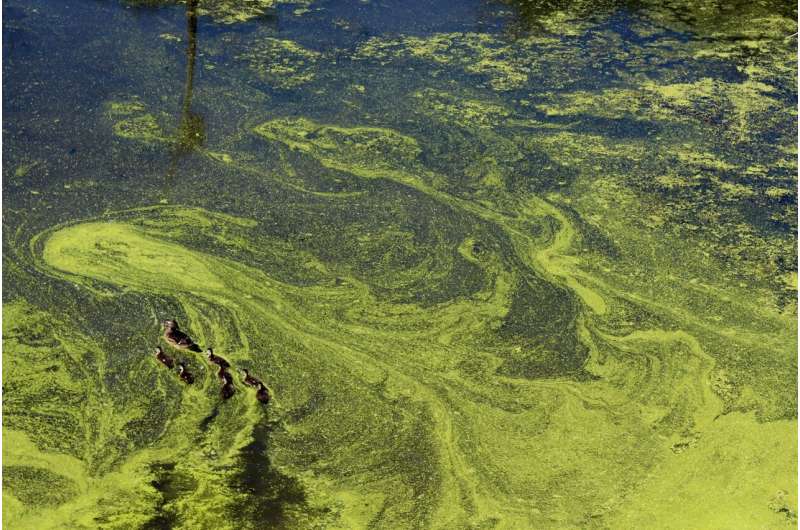This article has been reviewed according to Science X's editorial process and policies. Editors have highlighted the following attributes while ensuring the content's credibility:
fact-checked
reputable news agency
proofread
Eight Colorado lakes suspected of toxic algae blooms: Why it is becoming worse

Colorado's lakes serve as a needed respite during sweltering summer days, but as climate warms, the state's lakes are becoming more susceptible to toxic blooms of algae.
Colorado Parks and Wildlife officials have closed several lakes to swimming and other recreation over recent weeks due to toxic algae blooms that can sicken swimmers and kill pets. The agency closed parts of Cherry Creek Reservoir on Sunday, as well as the swim beach at North Sterling Reservoir.
At least four lakes and reservoirs across the state have tested positive for toxins so far this summer: Deweese Reservoir outside Westcliffe, Road Canyon Reservoir south of Lake City, Barr Lake near Brighton and Cherry Creek Reservoir outside Denver, according to data collected by Colorado Public Health and Environment. Possible blooms have been reported in eight others, including Blue Heron Lake at St. Vrain State Park outside Longmont.
The number of algae blooms will increase as Colorado's climate becomes warmer, said Ed Hall, a scientist at the Natural Resource Ecology Laboratory at Colorado State University. Even an increase in water temperatures of one or two degrees can exponentially increase algae growth, he said.
"In the face of human-caused climate change, the slight change in warmer temperatures can lead to an explosion in algal growth," Hall said.
CDPHE tests different lakes and reservoirs every year for algae under a program they began in 2019, said Sarah Erickson, a scientist with the department. Other entities—like municipalities or water utilities—also do their own testing of other lakes, she said. There is no statewide repository of data on algae blooms.
The blue-green algae found in the lakes are naturally occurring and an important part of the ecosystem. But the blooms can produce toxins if they grow big enough. Harmful algae looks like thick pea soup or spilled paint with a green, red, gold or turquoise color. They also often have foam or scum.
"When in doubt, stay out," Erickson said. "That's a good rule of thumb."
Symptoms of algae exposure include skin irritation, diarrhea, stomach pain, fever, headache or a sore throat. The toxins can be fatal to pets, like dogs that swim in the waters.
Algae blooms are one of the most visible consequences of climate change in Colorado, Hall said. Lakes that people are used to swimming in to cool off are closing more often. Waters that used to be blue and clear are instead covered in green algae.
Not all blooms are toxic, but even the non-toxic kind impact waters. When blooms die, they pull oxygen out of the water column, which can lead to large fish kills, Hall said.
Blooms have impacted many Denver-area lakes and reservoirs. Denver public health officials closed access to Sloan's Lake in 2021 due to algae. Cherry Creek Reservoir tested positive for toxins in 2014, 2016, 2020 and 2022, according to CDPHE. Barr Lake has tested positive for toxins every year since 2019.
Even high alpine lakes with few human visitors are experiencing increased blooms. A study of two popular lakes in Rocky Mountain National Park—Sky Pond and Loch Vale—found that the green algae on the bottom of the lakes have grown dramatically since 2010. Concentrations of the algae and cyanobacteria are more than 200% higher than in 1950, according to the research. Scientists attributed the increase in part to warmer summers.
"It's not a small problem, and it's not going to get any better without concerted effort," Hall said.
Coloradans can help prevent toxic algae blooms by avoiding lawn and garden fertilizer that includes phosphorus, Hall said. When it rains, the nutrient is washed into streams and lakes and gives algae the food it needs to grow.
"The same compounds that make tomatoes look great are great for algae," Hall said.
Coloradans also need to pick up their animals' waste and refrain from using de-icers that contain urea, a form of nitrogen, according to CDPHE.
Algae blooms typically recede as the weather cools or if wind or storm mixes the water, according to CDPHE.
2023 MediaNews Group, Inc. Distributed by Tribune Content Agency, LLC.





















